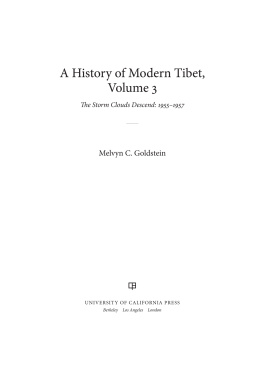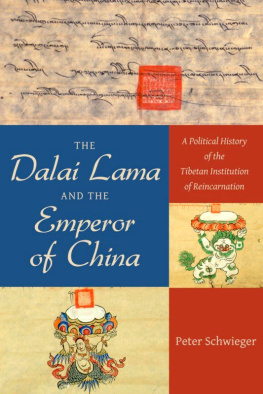
A History of Modern Tibet,
Volume 3

Book
The Philip E. Lilienthal imprint honors special books in commemoration of a man whose work at University of California Press from 1954 to 1979 was marked by dedication to young authors and to high standards in the field of Asian Studies. Friends, family, authors, and foundations have together endowed the Lilienthal Fund, which enables UC Press to publish under this imprint selected books in a way that reflects the taste and judgment of a great and beloved editor.
A History of Modern Tibet,
Volume 3
The Storm Clouds Descend: 19551957
Melvyn C. Goldstein

UNIVERSITY OF CALIFORNIA PRESS
BerkeleyLos AngelesLondon
University of California Press, one of the most distinguished university presses in the United States, enriches lives around the world by advancing scholarship in the humanities, social sciences, and natural sciences. Its activities are supported by the UC Press Foundation and by philanthropic contributions from individuals and institutions. For more information, visit www.ucpress.edu.
University of California Press
Berkeley and Los Angeles, California
University of California Press, Ltd.
London, England
2014 by The Regents of the University of California
Library of Congress Cataloging-in-Publication Data
Goldstein, Melvyn C.
A history of modern Tibet. Volume 3, The storm clouds descend, 19551957 / Melvyn C. Goldstein.
pagescm
Continues: A history of modern Tibet. Volume 2, The calm before the storm, 19511955.
Includes bibliographical references and index.
ISBN 978-0-520-27651-2 (hardback)
ISBN 978-0-520-95671-1 (e-book)
Tibet Autonomous Region (China)History19512. Tibet Autonomous Region (China)Politics and government1951I. Goldstein, Melvyn C. History of modern Tibet. Volume 2, The calm before the storm, 19511955. II. Title. III. Title: storm clouds descend, 19551957.
DS786.G6352013
951.505dc23 2013030870
Manufactured in the United States of America
23 22 21 20 19 18 17 16 15 14
10 9 8 7 6 5 4 3 2 1
In keeping with a commitment to support environmentally responsible and sustainable printing practices, UC Press has printed this book on Natures Natural, a fiber that contains 30% post-consumer waste and meets the minimum requirements of ANSI/NISO Z 39.48-1992 ( R 1997) ( Permanence of Paper ).
For my sister, Lyn, and my brother, Jay,
and, as ever, for CMB
The publisher gratefully acknowledges the generous support of the Philip E. Lilienthal Asian Studies Endowment Fund of the University of California Press Foundation, which was established by a major gift from Sally Lilienthal.
We can be almost certain of being wrong about the future if we are wrong about the past.
G.K. CHESTERTON
CONTENTS
ILLUSTRATIONS
FIGURES
MAPS
PREFACE
My first exposure to the intricacies of modern Tibetan history occurred in 1964 while I was a PhD student in anthropology and Tibetan studies at the University of Washington. The universitys Far East and Russian Institute invited Wangchen Gelek Surkhang, the famous kaln (Kashag minister) in the traditional Tibetan government, to campus for a year to participate in its Inner Asia Project, and he ended up living with me for that year. Although I was officially in the Anthropology Department, I had received my BA and MA degrees in history from the University of Michigan and was then immersed in trying to understand modern Tibetan society and history, since my dissertation project was going to be a reconstruction of the Tibetan government and socioeconomic system through interviews with Tibetan refugees in India. Consequently, I took Surkhangs visit as an opportunity to clarify the many things I had been puzzling over concerning Tibetan history and society.
It was an amazing year. Typically, we would finish dinner and then retire to the living room for a cup of tea and conversation about modern historical events and figures and whatever else Kaln Surkhang felt like discussing. Surkhang, who had an amazing, almost photographic memory for detail, would regale me with accounts of the great events and people in modern Tibetan history, such as Reting Rinpoche, Lungshar, Kunphela, Tsarong Dzasa, Trimn, Kapshba, and Khyungram. In retrospect, it was somewhat analogous to a student studying the Vietnam era having a yearlong independent studies course with Henry Kissinger.
It did not take long for me to realize that a different level of analysis than currently existed in the classic historical studies such as Hugh Richardsons Tibet and Its History was needed to meaningfully understand modern Tibetan history, and I made a commitment to myself to undertake to write such a history as soon as I received my PhD in anthropology and got settled into academia.
All of that took much longer than anticipated, and it was not until 1980 that I was able to free up the time to make a concerted effort to collect the primary data that existed in British and U.S. archives and conduct extensive oral history interviews with former officials. My initial plan to write a new, more detailed and nuanced single-volume history of modern Tibet has turned into a four-volume modern history project, two of which are completed, with this volume being number three.
From the start, I divided modern Tibetan history into three periods. The first extended from 1913 to 1951 and was the period during which Tibet operated as a de facto independent polity ruled by the Dalai Lama and a bureaucracy comprised of monk and aristocratic officials. That first period was the subject of volume 1, A History of Modern Tibet, 1913 1951 : The Demise of the Lamaist State.
The second period was the era between the end of the de facto independent polity in 1951 and the end of the Tibetan government and estate system after the failed Tibetan uprising in 1959. The first half of that period, 19511955, was covered in volume 2, A History of Modern Tibet: The Calm before the Storm, 1951 1955 .
I originally planned for the current volumevolume 3to cover the rest of the period (i.e., 19551959), but after I started work, it became apparent that there was too much new material from both Chinese and Tibetan sources to compress it into a single volume, so I decided to divide the period into two. Volume 3, therefore, begins with the return of the Dalai Lama from his four-month visit to China in June 1955 and ends in the spring of 1957, when two major events occurred.
On the Tibetan side, despite being constantly pressured to enter exile to head an migr organization, the Dalai Lama decided it was best to return, and he arrived in Lhasa on 1 April 1957.
On the Chinese side, at about the same time, Mao Zedong also made a major decision not to implement reforms in Tibet and to dismantle Fan Mings Great Expansionthrough which Fan was preparing to start democratic reforms in Tibetand replace it with his own Great Contraction.
What happened after this, and why, will be the subject of the next and last volume.
WRITING CONTEMPORARY TIBETAN HISTORY
The late Tsipn Shakabpa, one of the great figures in modern Tibetan history and politics, once told me not to write anything that would hurt the Tibetan cause. I understood his view, but in the end, when it came time to write up my research on Tibetan history, as an American academic I could not do thatany more than I could have ignored Abu Ghraib or Guantanamo while writing a history of the United States in the Middle East because it would hurt the reputation and relations of the United States in the Arab world.
Next page










